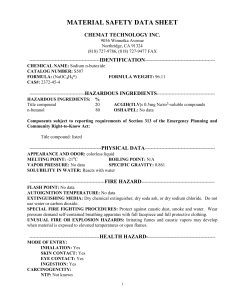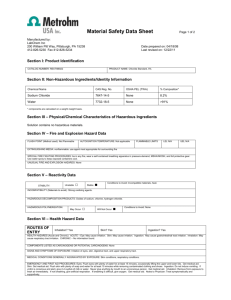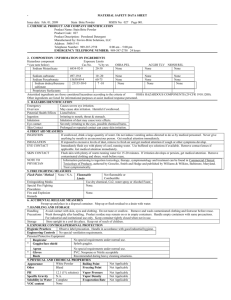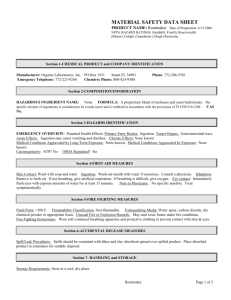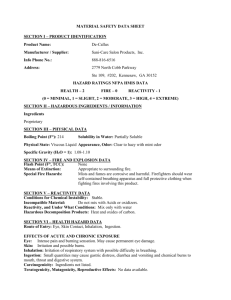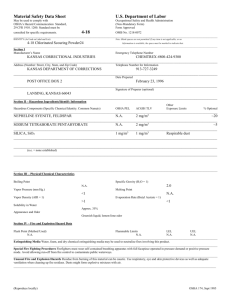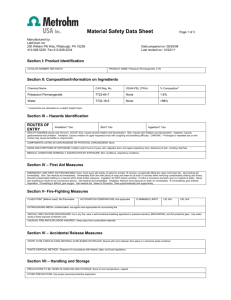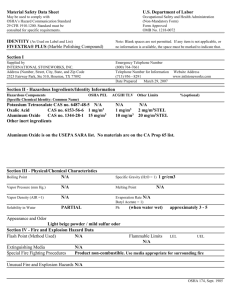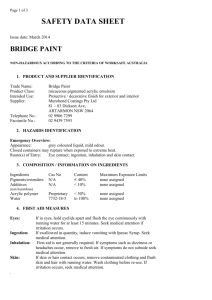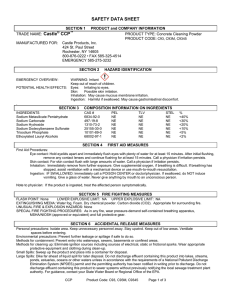Print Date: 10/08/2002
advertisement
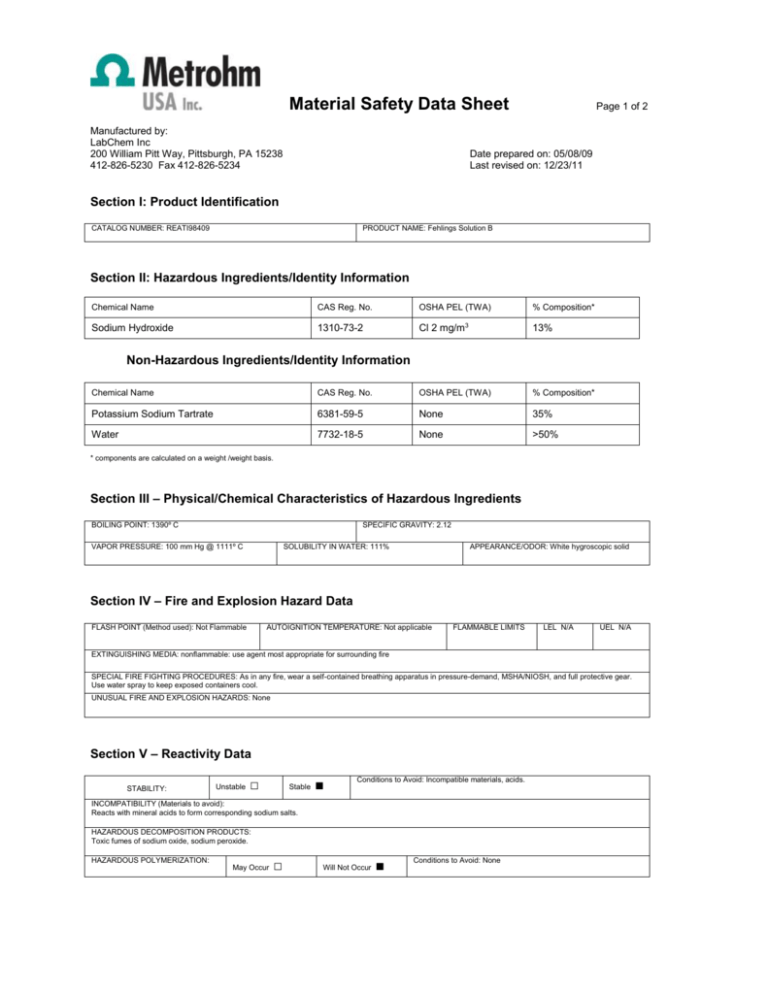
Material Safety Data Sheet Manufactured by: LabChem Inc 200 William Pitt Way, Pittsburgh, PA 15238 412-826-5230 Fax 412-826-5234 Page 1 of 2 Date prepared on: 05/08/09 Last revised on: 12/23/11 Section I: Product Identification CATALOG NUMBER: REATI98409 PRODUCT NAME: Fehlings Solution B Section II: Hazardous Ingredients/Identity Information Chemical Name CAS Reg. No. OSHA PEL (TWA) % Composition* Sodium Hydroxide 1310-73-2 Cl 2 mg/m3 13% Non-Hazardous Ingredients/Identity Information Chemical Name CAS Reg. No. OSHA PEL (TWA) % Composition* Potassium Sodium Tartrate 6381-59-5 None 35% Water 7732-18-5 None >50% * components are calculated on a weight /weight basis. Section III – Physical/Chemical Characteristics of Hazardous Ingredients BOILING POINT: 1390º C SPECIFIC GRAVITY: 2.12 VAPOR PRESSURE: 100 mm Hg @ 1111º C SOLUBILITY IN WATER: 111% APPEARANCE/ODOR: White hygroscopic solid Section IV – Fire and Explosion Hazard Data FLASH POINT (Method used): Not Flammable AUTOIGNITION TEMPERATURE: Not applicable FLAMMABLE LIMITS LEL N/A UEL N/A EXTINGUISHING MEDIA: nonflammable: use agent most appropriate for surrounding fire SPECIAL FIRE FIGHTING PROCEDURES: As in any fire, wear a self-contained breathing apparatus in pressure-demand, MSHA/NIOSH, and full protective gear. Use water spray to keep exposed containers cool. UNUSUAL FIRE AND EXPLOSION HAZARDS: None Section V – Reactivity Data STABILITY: Unstable □ Stable ■ Conditions to Avoid: Incompatible materials, acids. INCOMPATIBILITY (Materials to avoid): Reacts with mineral acids to form corresponding sodium salts. HAZARDOUS DECOMPOSITION PRODUCTS: Toxic fumes of sodium oxide, sodium peroxide. HAZARDOUS POLYMERIZATION: May Occur □ Will Not Occur ■ Conditions to Avoid: None Material Safety Data Sheet Page 2 of 2 Section VI – Health Hazard Data ROUTES OF ENTRY Inhalation? Yes Skin? Yes Ingestion? Yes HEALTH HAZARDS (Acute and Chronic): ACUTE – Eye: causes severe eye burns. Skin: Causes skin burns. May cause deep, penetrating ulcers of the skin. Ingestion: Causes gastrointestinal tract burns. Causes severe pain, nausea, vomiting, diarrhea, and shock. Inhalation: Irritation may lead to chemical pneumonitis and pulmonary edema. Causes severe irritation of upper respiratory tract with coughing, burns, breathing difficulty, and possible coma. CHRONIC – Prolonged or repeated skin contact may cause dermatitis. COMPONENTS LISTED AS CARCINOGENS OR POTENTIAL CARCINOGENS: None SIGNS AND SYMPTOMS OF EXPOSURE: Irritation and/or burns of eyes, skin, digestive tract, and upper respiratory tract. MEDICAL CONDITIONS GENERALLY AGGRAVATED BY EXPOSURE: Skin conditions, respiratory conditions. EMERGENCY AND FIRST AID PROCEDURES: Eyes: Flush eyes with plenty of water for at least 15 minutes, occasionally lifting the upper and lower lids. Get medical aid immediately. Skin: Get medical aid immediately. Immediately flush skin with plenty of soap and water for at least 15 minutes while removing contaminated clothing and shoes. Discard contaminated clothing in a manner which limits further exposure. Ingestion: Do NOT induce vomiting. If victim is conscious and alert, give 2-4 cupfuls of milk or water. Never give anything by mouth to an unconscious person. Get medical aid immediately. Inhalation: Remove from exposure to fresh air immediately. If not breathing, give artificial respiration. If breathing is difficult, give oxygen. Get medical aid. Notes to Physician: Treat symptomatically and supportively. Section VII – Precautions for Safe Handling and Use STEPS TO BE TAKEN IN CASE MATERIAL IS RELEASED OR SPILLED: Absorb with inert material, then place in a chemical waste container. WASTE DISPOSAL METHOD: Dispose of in a manner consistent with federal, state and local regulations. PRECAUTIONS TO BE TAKEN IN HANDLING AND STORAGE: Store at room temperature, capped. OTHER PRECAUTIONS* Use proper personal protective equipment. Section VIII – Control Measures RESPIRATORY PROTECTION (Please specify): Follow OSHA respirator regulations found in 29 CFR 1010.134 when necessary. VENTILATION: Provide local exhaust or general dilution ventilation. PROTECTIVE GLOVES: Wear appropriate gloves. EYE PROTECTION: Wear appropriate protective glasses or chemical safety goggles. OTHER PROTECTIVE EQUIPMENT: None EMERGENCY WASH FACILITIES: Provide an eye-wash fountain in work area. Section IX – WHMIS Class: E Corrosive Material The information stated in this Material Safety Data Sheet (MSDS) is believed to be correct on the date of publication and must not be considered all conclusive. The information has been obtained only by a search of available literature and is only a guide for handling the chemicals. Persons not specifically and properly trained should not handle this chemical or its container. This MSDS is provided without warranty expressed or implied, including merchantability or fitness for any particular purpose. This product is furnished for laboratory use ONLY! Our standards may not be used as drugs, cosmetics, agricultural or pesticide products, food additives or as household chemicals. * Various Government agencies (i.e., Department of Transportation, Occupational Safety and Health Administration, Environmental Protection Agency, and others) may have specific regulations concerning the transportation, handling, storage or use of this product which may not be contained herein. The customer or user of this product should be familiar with these regulations.

